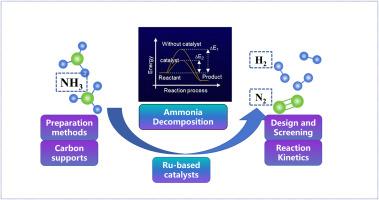氨分解中钌基催化剂中碳基载体的制备工艺:最新进展
IF 6.8
3区 材料科学
Q1 MATERIALS SCIENCE, MULTIDISCIPLINARY
Journal of Science: Advanced Materials and Devices
Pub Date : 2025-06-15
DOI:10.1016/j.jsamd.2025.100929
引用次数: 0
摘要
在氨分解制氢反应中,钌因其优异的催化性能而被常用作催化剂。近年来的研究主要集中在钌基催化剂的反应机理、微观结构和载体以及各种掺杂元素对催化剂性能的调节等方面,旨在降低钌的负荷量,提高其在低温应用中的催化效率。本文综述了钌催化氨分解的基本机理和催化剂制备方法的最新进展,重点介绍了碳基催化剂载体对氨分解活性的影响。浸渍法可以增强钌在载体上的分散,从而增加有效活性位点的数量。沉淀沉积法控制了沉淀形成过程中金属-载体的相互作用,有利于金属的稳定性和活性位点的生成,从而提高氨分解反应的效率。溶胶-凝胶法可以制备具有表面特征的催化剂载体,改变钌的电子密度,优化其与氨分子的相互作用,从而提高其催化活性。碳基载体的高比表面积和优化的孔隙结构有利于Ru颗粒的吸附或分散,从而提高Ru的电子密度。较高的电子密度可以增强Ru表面电子与氨分子之间的吸引力,从而促进氨分子的吸附和解离。同时,较高的电子密度可能降低氮-氮键的结合能,有利于其解理,加速氨分解过程。在讨论钌基氨分解催化剂的新兴发展方向时,我们还介绍了氨分解催化剂的新兴研究趋势,包括:(1)使用高通量筛选策略进行组分预测和优化;(2)结合机器学习和计算模拟进行动力学过程分析。本文章由计算机程序翻译,如有差异,请以英文原文为准。

Processes for fabricating carbon-based supports in Ru-based catalysts in ammonia decomposition: A state-of-art review
In the ammonia decomposition reaction for hydrogen production, ruthenium is commonly used as a catalyst because of its excellent catalytic performance. Recent research has focused on the reaction mechanism of ruthenium-based catalysts, their microstructure and support, as well as the modulation of catalyst performance by various dopant elements, aiming to reduce ruthenium loading and enhance its catalytic efficiency for low-temperature applications. This review summarizes the fundamental mechanisms of ruthenium-catalyzed ammonia decomposition and recent advances in catalyst preparation methods, with particular emphasis on the influence of carbon-based catalyst supports on ammonia decomposition activity. The impregnation method can enhance the dispersion of ruthenium on the support, thereby increasing the number of effective active sites. The precipitation deposition method controls the metal-support interactions during precipitation formation, contributing to the stability of the metal and the generation of active sites, thus improving the efficiency of ammonia decomposition reactions. The sol-gel method can produce catalyst support with surface features that can alter the electronic density of ruthenium, optimizing its interactions with ammonia molecules, and thereby enhancing its catalytic activity. The high specific surface area and the optimized pore structure of the carbon-based support facilitate the adsorption or dispersion of Ru particles, thereby increasing the electronic density of Ru. A higher electronic density could enhance the attraction between the electrons on the Ru surface and ammonia molecules, thereby promoting the adsorption and dissociation of ammonia molecules. At the same time, a higher electronic density may lower the binding energy of the nitrogen-nitrogen bond, facilitating its cleavage and accelerating the ammonia decomposition process. In discussing emerging directions for development in ruthenium-based ammonia decomposition catalysts, we also introduced the emerging research trends in ammonia decomposition catalysts, including (1) component prediction and optimization using high-throughput screening strategies and (2) combined machine learning and computational simulations for kinetic process analysis.
求助全文
通过发布文献求助,成功后即可免费获取论文全文。
去求助
来源期刊

Journal of Science: Advanced Materials and Devices
Materials Science-Electronic, Optical and Magnetic Materials
CiteScore
11.90
自引率
2.50%
发文量
88
审稿时长
47 days
期刊介绍:
In 1985, the Journal of Science was founded as a platform for publishing national and international research papers across various disciplines, including natural sciences, technology, social sciences, and humanities. Over the years, the journal has experienced remarkable growth in terms of quality, size, and scope. Today, it encompasses a diverse range of publications dedicated to academic research.
Considering the rapid expansion of materials science, we are pleased to introduce the Journal of Science: Advanced Materials and Devices. This new addition to our journal series offers researchers an exciting opportunity to publish their work on all aspects of materials science and technology within the esteemed Journal of Science.
With this development, we aim to revolutionize the way research in materials science is expressed and organized, further strengthening our commitment to promoting outstanding research across various scientific and technological fields.
 求助内容:
求助内容: 应助结果提醒方式:
应助结果提醒方式:


